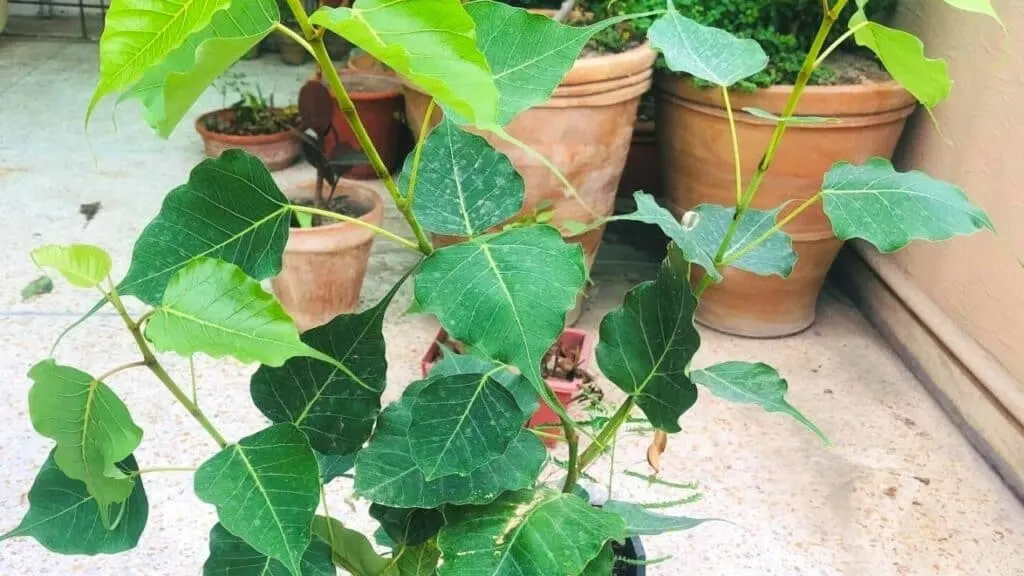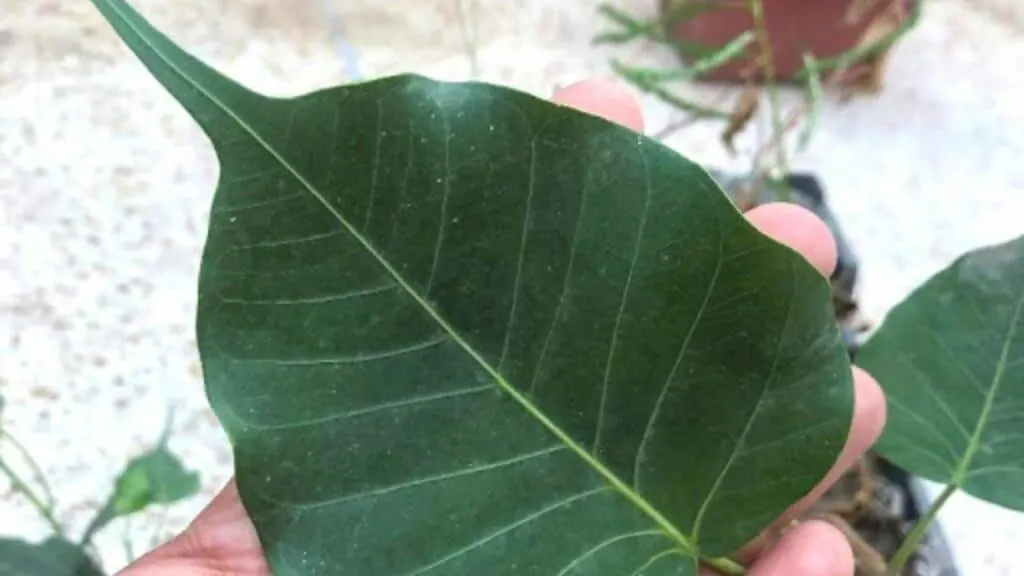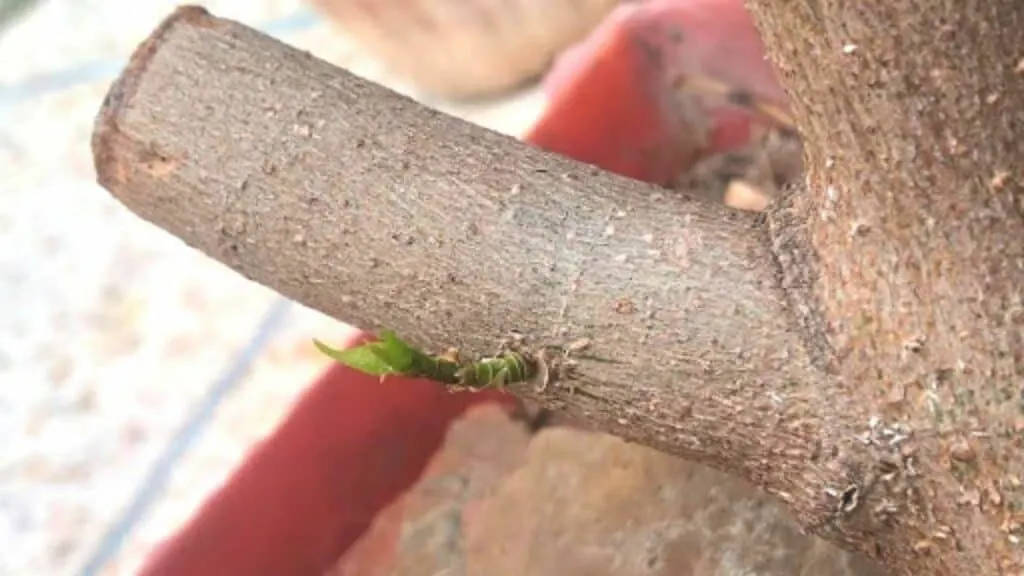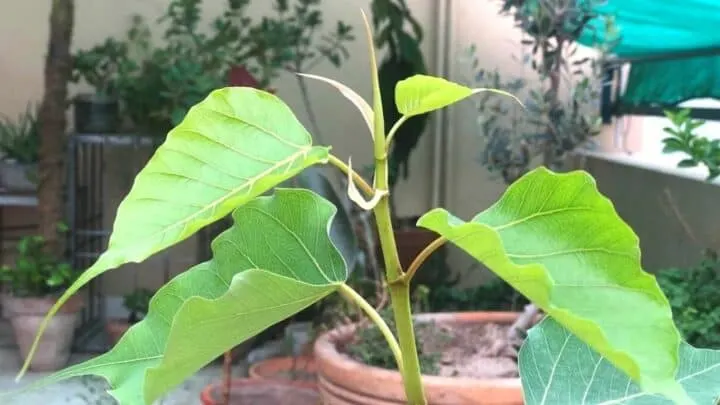Ficus Religiosa is a truly magnificent tree native to the Indian subcontinent.
With heart-shaped leaves and long drip tips, this beautiful Ficus species radiates vibes of wisdom.
Known as the Peepal tree in local languages, this semi-evergreen, deciduous species holds great historical and religious significance.
It is the same tree under which the Buddha is believed to have attained enlightenment, hence also known by the names Sacred fig, or Bodhi tree.
Read everything about the care of Ficus Religiosa.
Ficus Religiosa Care
Ficus Religiosa does well in loose, fertile soil with good drainage. It likes to grow in direct sunlight but can do equally well in partial shade. This plant will only require water in minimal amounts. The optimum growing temperature is between 77-95°F (25-35°C).

Ficus religiosa
Table of Contents
Ficus Religiosa Care
For ideal Ficus Religiosa care, choose loose, well-draining soil. Provide ample sunlight with at least a couple of hours of direct sunlight per day. Water sparingly when the soil dries out. Maintain a warm temperature range between 77-95°F. Keep humidity levels at 40-80% for optimal growth.
Soil
Ficus Religiosa does well in loose, fertile soil with good drainage. The Sacred fig will not grow well if the soil is too compacted as its roots need adequate aeration. Regular potting mix can be used with extra sand and organic matter to reduce its heaviness.
The Ficus Religiosa is a resilient species and can survive in the toughest of environments. In its native region, the Sacred fig tree only grows in places where there are people.
Across the Indian subcontinent, Ficus religiosa saplings are rarely found growing out of the ground. Unlike most trees that naturally germinate in soft and moist soil, it is most often found growing out from cracks in walls, rock crevices, and on the trunks of other trees!
Seeing this remarkable ability of the tree to grow virtually anywhere, one may be able to deduce that it’ll grow well regardless of the soil type.
The fact that it can thrive even in a solid brick wall is evidence that it needs nothing more than soil drainage and aeration to thrive.

Ficus Religiosa Full Plant
Light
The Bodhi tree likes to grow in direct sunlight but can do equally well in partial shade.
If planting outdoors, plant the tree in an open space that receives direct sunlight all day. If growing indoors, make sure it receives bright indirect light by placing it next to a window.
Baby Sacred fig plants are usually found in low-light and shaded areas. However, for the plant to develop into a big tree, it needs exposure to sunlight.
Vigorous growth is only triggered when this tree receives at least 6 hours of direct sunlight every day. If you want your Sacred Fig plant to grow into a big tree really quickly, you better give it the sunlight it needs.
But even if this plant does not receive direct sunlight, it can still stay healthy in bright indirect light or shade. If you decide to bring the plant indoors, give it a place next to the window or under a grow light.
The Ficus religiosa is not one of the low-light tolerant Ficus species. It sheds all its foliage pretty quickly if it doesn’t get enough light.
Watering
Ficus religiosa plants are not heavy drinkers and will only require water in minimal amounts. These plants can survive severe dry spells. Water the plant in moderation only when the soil is dry.
Make sure excess water does not stand in the soil but flows out from the drainage hole.
The Sacred fig tree is a truly remarkable species when it comes to survival in hot and dry conditions. These plants can often be seen growing from tree trunks and cracks that can seem pretty lacking in moisture.
This proves that Ficus Religiosa seed can not only germinate but grow quite well in the absence of adequate soil moisture. The roots of this plant have a strange growing habit as they usually grow far and wide in the ground in search of water.
When watering your plant, water it only when the soil is completely dry to imitate its natural growing conditions and to encourage lateral root growth, so the root system gets well-established.
This drought-tolerant Ficus species has a unique mechanism to survive in severely dry conditions. Apart from lateral root growth, the plant quickly sheds all its leaves when it does not receive water for a long time.
This enables the plant to reduce its water transpiration rates down to 0 immediately and conserve water in its trunk to survive dry spells. It grows back new foliage when the dry period ends.
This tree is particularly well-suited to grow in dry conditions but will not do well if you over-water it constantly. Being a tough plant to kill, it will give you some leeway even when you overwater it by showing signs like dull and droopy leaves.
This is a sign that you need to stop watering the plant immediately and start root rot treatment.
Temperature
Like all tropical Ficus species, the Ficus religiosa loves hot conditions. Optimum growing temperatures are between 77-95°F (25-35°C). The plant will stop growing below 50°F(10°C) and must be brought indoors if winter temperatures go below the freezing point.
During the winter, Ficus religiosa enters its dormancy period and does not grow. It loses a lot of its old foliage as the winter progresses, and some trees can lose up to half of their leaves.
New growth begins as soon as winter ends. The Bodhi tree springs with rampant growth throughout spring and summer. As soon as the temperatures warm up, you will see your plant grow new foliage on a daily basis.
This plant can be grown outdoors year-round in USDA Hardiness Zones 10-11. However, you will have to bring your Sacred fig plant indoors if you live in zones 4b-9.
Humidity
Being a tropical plant, adequate humidity levels are essential for a Bodhi tree to thrive. It grows most rapidly when provided hot and humid conditions. The optimum humidity levels for Ficus Religiosa are 40-80%.
In their native habitat, Sacred fig trees thrive the most in the hot and humid monsoon season. It is the same season whereby its seeds germinate from underneath walls and crevices owing to the high atmospheric moisture.
The Bodhi tree can also grow beautiful aerial roots in high-humidity conditions. If you are growing this plant as a Bonsai tree or its aesthetics, you can artificially increase the humidity levels around the tree to induce aerial roots.
To help your plant grow aerial roots, place pieces of clay pot break or bricks in a pile around your tree to increase the humidity. You will also need to use a humidifier or humidity tray to notch up the humidity if you bring your Ficus religiosa indoors for the winter.
Fertilizer
Fertilizing the Sacred Fig tree is not an absolute must. The robust Ficus species can grow well on its own. However, its growth rate can be enhanced by using liquid or organic fertilizer throughout the growing season.
As mentioned above, Ficus religiosa grows its roots in a unique manner in search of water and nutrients.
Typically, trees grow a primary taproot that anchors the tree in the ground and other feeding roots in a fan shape.
Bodhi trees grow their roots laterally.
The roots spread far and wide out of the trunk in a circular shape and can stretch for many meters across the ground in search of nutrients.
This root-growing behavior of the plant allows it to gather all the nutrients it needs, even in infertile land.
You will not need to worry about feeding your Ficus religiosa if planted in the ground.
However, if grown in a container or as Bonsai, it can be provided with moderate liquid or organic fertilizer applications.
You must note that highly nitrogenous fertilizer will make this plant grow tall. If you want it to remain short and bushy, cut back on the nitrogenous content.
Growth
The Sacred Fig tree is a rampant grower. Mature trees can grow as tall as 15-30 meters with wide crown-like branching. The leaves grow in clutches on the ends of stems. It grows throughout the spring and summer, but most vigorously in high heat and humidity.

Ficus Religiosa Leaf
In nature, Ficus religiosa primarily grows epiphytically.
It germinates on another tree trunk and slowly grows aerial roots to sustain itself as it gets larger.
When it grows into a big tree, the Sacred Fig indeed looks like a king tree with a vast canopy stretching up to 60-100 feet in width. It has a grand trunk and aerial roots, making it a perfect meditation site.
Potting
Ficus religiosa does better in clay pots as compared to plastic or ceramic ones. The roots do not get enough air in a plastic pot, and the plant is susceptible to root rot. Make sure the pot has adequate drainage and can support the plant as it grows big.
It is evident that a plant will not grow as big in a pot as it will if grown in the ground. After growing to a specific height, the growth of a Sacred fig tree will be slowed down because of being root-bound.
The bigger the pot you use, the bigger you can grow your Bodhi tree. A pot without drainage holes is a big no for this plant, and it will die if planted in one.
Ficus religiosa performs better in a clay pot because the porous quality of the clay allows air exchange between the soil and the environment, keeping it well-aerated.
Pruning
Your Ficus religiosa will require regular pruning when grown indoors or for decorative purposes. Pruning should ideally be done during spring or fall. This plant responds well to pruning, making it excellent for Bonsai.
Such is the growing speed of this tropical tree, a new set of leaves can be seen daily during the growing season.
When growing it as a houseplant, you will very often find your Ficus religiosa outgrowing its allocated space.
The plant gets taller with every new leaf and can stand towering above your head before you even notice.
You will need to prune it back to size to prevent it from taking over your home.
Pinching off the new growth at the top of a branch will stop that stem from growing further and will activate buds lower down on the plant, leading to more branching and a bushier look.

Ficus Religiosa Buds
You can also hard prune your Ficus religiosa plant back to size, and new growth will spring up in a few days, looking even better than before.
Ficus Religiosa Propagation
Ficus religiosa is one of the easiest Ficus species to propagate vegetatively. It can be easily be grown by rooting cuttings in water or soil. Air layering can be done to root thick branches for Bonsai.
In its native region, the Ficus Religiosa is believed to germinate only when its seed has been ingested by a bird and then excreted.
This belief is supported by the observation that these plants are only found to germinate on walls and tree trunks, the usual places for birds to sit.
Studies have proved that the Ficus Religiosa is extremely difficult to grow from seed.
Even more, evidence that the seeds need to go through a bird’s gut to germinate. However, these plants can easily be propagated through cuttings.
Take hardwood cuttings from the Sacred fig tree and place them in a well-drained and moist potting mix.
The cuttings will root within a few weeks during the growing season.
The cuttings will dry up if exposed to the sun for too long, so place them in a shaded area.
Common Problems with Ficus Religiosa
Ficus religiosa is an invasive species in its natural habitat and is primarily immune to catching pests and diseases.
Apart from over-watering and freezing cold, there aren’t many things that can make life difficult for the Sacred fig.
Although the tree loves heat and direct sunlight, you may find a leaf or two all dried and curled up from the edges. This is not a worrisome sign.
This usually occurs when the leaves come into prolonged contact with a hot surface such as a wall or glass in direct sunlight.
Conclusion
The Sacred fig is easy to care for and a great plant for novice plant parents. This beautiful plant is quite forgiving and will give you many chances even if you under or over-water it.
Grow it indoors or outdoors.
The unique-looking leaves and their magnificent patterns will surely add a spiritual vibe to your space.
Frequently Asked Questions About Ficus Religiosa
What is Ficus Religiosa?
Ficus Religiosa is a tree native to India. It is said that Buddha received enlightenment sitting under this tree.
What is the common name for Ficus Religiosa?
The common name for Ficus Religiosa is sacred fig or Peepal tree.
Where can you buy Ficus Religiosa?
Ficus religiosa can be bought on Amazon, Etsy, and eBay as well as in garden centers.
Why defoliate Ficus Religiosa bonsai?
Ficus Religiosa can be defoliated when healthy to promote new foliage growth.
How to grow Ficus Religiosa?
To grow Ficus Religosa water sparingly and grow it in temperatures between 77-95°F (25-35°C) are best. Provide loose well-draining fertile soil. Provide indirect light with a couple of hours of direct sunlight in the morning.

Daniel has been a plant enthusiast for over 20 years. He owns hundreds of houseplants and prepares for the chili growing seasons yearly with great anticipation. His favorite plants are plant species in the Araceae family, such as Monstera, Philodendron, and Anthurium. He also loves gardening and is growing hot peppers, tomatoes, and many more vegetables.


